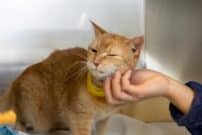Helping Your Senior Cat with Impaired Mobility

Helping Your Senior Cat with Impaired Mobility
Rudy (pictured) is one of my oldest feline patients. At 17 years of age, Rudy has a number of health conditions including small cell intestinal lymphoma, congestive heart failure, asthma and hyperthyroidism. At his last clinic visit, his owner had a new concern: pooping and peeing outside the litterbox.
Blood tests did not show a cause for this new behavior, but when I asked the owner to describe the issue, she said Rudy’s front feet would be inside the litterbox while his back end would hang out of the box. That made me wonder if Rudy suffered from impaired mobility and could no longer climb into his box.
Feline Arthritis Reduces Mobility
Feline arthritis is common, yet underdiagnosed in cats. With a slow, subtle onset, cat owners rarely recognize their favorite fur person no longer jumps on top of the refrigerator or scales the cat tree because arthritis has made these activities impossible. Arthritic cats may be reluctant to climb stairs and may have trouble getting to a litterbox if it’s in an upstairs location. Typically, cat families think their cat has finally outgrown the crazy kitten phase and are surprised to hear the cause of inactivity might be arthritis.
Recommendations for Rudy
Given Rudy’s many health conditions, adding an arthritis medication to his regimen was not an option without causing some significant drug interactions. I started by recommending a litter box ramp to ease his entry to “the facilities.” Using the search term “cat litterbox ramp” I quickly found several ready for purchase, for example The Kitty Box Ramp or the Ramp & Scratch Pad.
If your cat doesn’t take to the litterbox ramp, there are also litter boxes with low entryways, designed for animals with mobility issues.
Food, Diet, and Other Solutions
Although Rudy had no issue with his appetite, many animals with mobility issues have trouble reaching down to their food bowls. This problem can be solved by raising the bowls that typically sit on the floor.
You might also consider filling those bowls with a prescription diet designed to improve mobility. If your veterinarian approves of changing the diet, read our tips on successfully switching your pet to a prescription diet.
For cats with severe mobility problems, a wheelchair might be the best solution. Watch this video of Benji learning to use his new wheels.



































